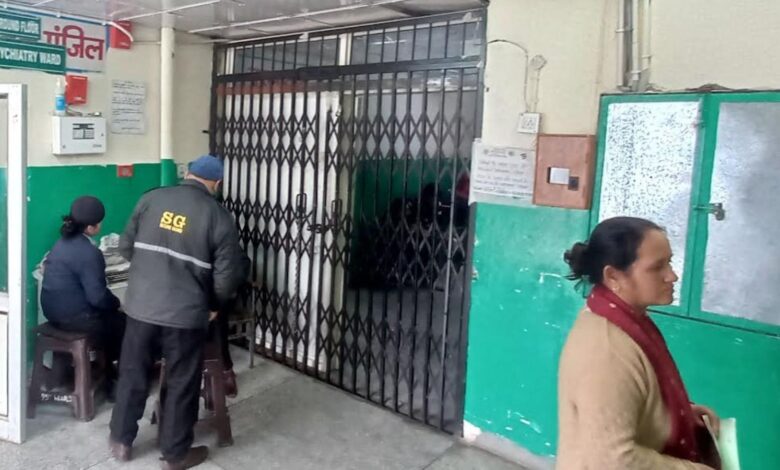Dangerous high: Himachal’s premier health institute IGMC, Shimla sees rise in opioid addicts | Chandigarh News

A 24-year-old native of Kulwari village near Ghumarwin in Himachal Pradesh’s Bilaspur district was rushed to the psychiatric ward of Indira Gandhi Medical College & Hospital (IGMC) when he began showing withdrawal symptoms. It’s been 15 days since the man—who said he became addicted to chitta (heroin) during a short stint as a factory worker in Punjab’s Ludhiana—has been admitted to the ward. His mother is the sole attendant.
Three days ago, a 21-year-old from Chopal in Shimla was taken to the IGMC’s psychiatric ward after he was detained by the police for allegedly attacking a bus driver and fellow passengers who objected when he smoked on a moving bus operated by the Himachal Roadways Transport Corporation (HRTC). Although his parents said that he is not an addict, doctors have been observing the youth’s severe withdrawal symptoms. The BSc dropout from a reputed college in Solan reportedly told his father that he had only taken chitta once. The nursing staff, however, had to restrain his hands and feet to prevent the youngster from harming himself.
Arrested for his alleged links with a recently busted inter-state drug-trafficking gang in Shimla, a 26-year-old was lodged at the Kaithu Jail in judicial custody, where he began exhibiting withdrawal symptoms. Prison staff rushed him to IGMC, where doctors admitted him in the psychiatric ward.
The well-guarded psychiatric ward in the E block of Himachal Pradesh’s premier health institute has witnessed a marked shift in the substances abused by patients over the last two years. The ward’s black sliding door remains chained shut at all times. At least three security personnel—including a female guard and a uniformed policeman—are on duty 24×7. The ward has a capacity of 30 beds, eight of which are earmarked for addicts.
Speaking to The Indian Express, Dr Dinesh Dutt Sharma, head of the Psychiatry Department at IGMC, Shimla, said, “Since 2023, we have noticed a change in the substances to which people are addicted before being rushed to IGMC under emergency conditions. In 2023, approximately 890 patients visited the psychiatric outpatient department (OPD), and 258 were admitted to the ward. Out of these, 116 were addicts — 89 were addicted to cannabis and 27 were addicted to opioids.”
Opioids refer to synthetic drugs, including heroin, that are addictive in nature. “In 2024, the total number of patients was 1,083, of whom 358 were admitted to the ward. Out of these, 145 were addicts. The number of patients addicted to opioids increased to 79, while those addicted to cannabis decreased to 66. In 2023, there were no female addict patients but in 2024, we admitted six such patients suffering from addiction to opioids,” he shared.
Dr Sharma maintained that although alcohol remains the most commonly used substance among patients presenting to the psychiatric OPD with withdrawal symptoms, alcoholic patients are rarely admitted to the ward. He explained, “Drug addiction falls under the category of chronic diseases. What makes chitta (heroin) dangerous is the high possibility of death from overdose, as victims tend to inject it. We have also observed that addicts who inject drugs are particularly vulnerable to Hepatitis C, known locally as Kala Piliya. The number of patients using bhang (cannabis) are being outnumbered by the patients using opioids.”
Story continues below this ad
Sources said that since there is no de-addiction centre at IGMC, patients suffering from various addictions—including heroin and opium—are treated and admitted to the psychiatric ward. Meanwhile, Himachal Pradesh’s first model de-addiction and rehabilitation centre is set to be established in Kotla Barog village of Sirmaur district’s Dado Deoria panchayat at a cost of Rs 5.34 crore. The centre will feature 100 beds and will be equipped with a team of specialised doctors, trained nurses and dedicated support personnel.
A faculty member at IGMC says, “The psychiatry ward has a capacity of 30 beds, eight of which are earmarked for addicts. However, there are times when the number of addicts reaches 15. Although we do not have a de-addiction centre at IGMC, specialist de-addiction psychiatrist Dr Nidhi Sharma conducts a special OPD twice a week for de-addiction patients.”
The faculty member added, “If you examine the profiles of patients suffering from various addictions, they range from lower-class to high-class backgrounds. We can only treat the addicts but can’t rehabilitate them.”
Meanwhile, between January 1, 2024, and February 25, 2025, at least 2,210 cases were registered under the Narcotic Drugs and Psychotropic Substances (NDPS) Act, 1985, resulting in the arrest of 2,921 suspects, including 131 women, across Himachal Pradesh. Out of these, 850 NDPS cases were registered solely in Shimla, where 1,600 peddlers were arrested—among them, five women. Spread across nearly 5,121 sq km, Shimla district has an estimated population of 9 lakh and 20 police stations to maintain law and order. Six suspected drug overdose deaths have been reported in the district in the last 15 months.
Story continues below this ad
Psychiatric OPD at Indira Gandhi Medical College & Hospital (IGMC), Shimla:
Shimla Superintendent of Police Sanjeev Gandhi said, “We have adopted a zero-tolerance policy against drug peddling, though the rehabilitation of addicts is also significant. We are working in collaboration with health experts.”
Standing outside the chained door of the psychiatric ward in IGMC, the father of the BSc dropout told The Indian Express, “I know my son smokes bhang (cannabis) and drinks alcohol but alcohol doesn’t show such severe withdrawal symptoms. My son once told me that he had used chitta once while studying in Solan. I have been praying that it wasn’t chitta that he used.”
“My son argued with me and demanded Rs 4,000. He said he had to go to Solan to meet some friends. I gave him the money but later that day received a phone call from the local police station informing that my son was detained there. When I reached the police station, he was behaving abnormally. They suggested that I bring him to IGMC,” the worried father added.
Story continues below this ad
340% rise in NDPS cases in Himachal
On January 11, Chief Minister Sukhvinder Singh Sukhu informed that the state has witnessed a 340 per cent rise in cases registered under the NDPS Act between 2012 and 2023, and the percentage of cases involving heroin has nearly doubled from 29 per cent to 50 per cent between 2019 and 2023. Sukhu presented these figures at a regional conference on Drug Trafficking and National Security in Delhi.
He added that the state police confiscated the properties of peddlers worth Rs 16 crore in the last three years, with Rs 9 crore confiscated in 2024 alone. Sukhu expressed concerns over the growing prevalence of synthetic drugs, noting their higher potency, addictive nature, and the challenges posed by their chemical composition.
The chief minister emphasised the need for a comprehensive approach to address drug trafficking, particularly in interstate border areas that have become hotspots for illegal activities. The conference was organised by the Narcotics Control Bureau (NCB) and chaired by Union Home Minister Amit Shah.






